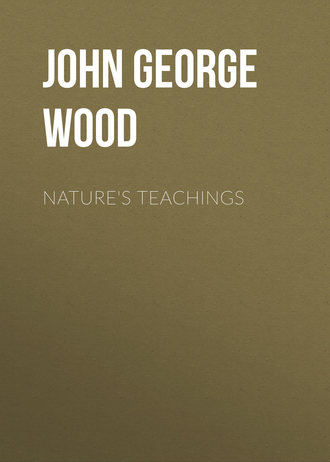 полная версия
полная версияNature's Teachings
The story of the Crystal Palace is now so well known that it need not be repeated in detail. A vast building was required for the Exhibition of 1851, and not an architect was able to supply a plan which did not exhibit some defect which would make the building almost useless.
Suddenly a Mr. Paxton, who was a gardener, and not an architect, produced (on a sheet of blotting-paper) a rough plan of a building on a totally new principle, and not only fulfilling all the requisite conditions, but being capable of extension in any direction and to any amount. There have been very few bolder conceptions than that of making iron and glass take the place of brick, stone, and timber, and the result fully justified the expectations even of the inventor.
How a gardener suddenly developed into an architect remains to be seen; and, indeed, in this case the architecture was the result of the gardening, or rather, of practical botany applied to art. Some years before the invention of the Crystal Palace, that magnificent plant, the Victoria Regia, had been introduced into England. Its enormous leaves, with their wonderful power of flotation, caused a great stir at the time, and some of my readers may remember a sketch which was engraved in the Illustrated London News, and which represented a little girl standing on one of these leaves as it floated on the water.
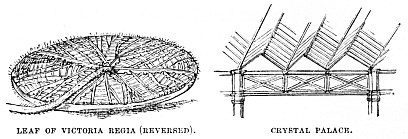
Mr. Paxton saw how this power was obtained, and the result was that he copied in iron the lines of the vegetable cellular structure which gave such strength to the Victoria Regia leaf, and became more eminent as an architect than he had been as a gardener. The capabilities of the Crystal Palace had lain latent for centuries, but the generalising eye of genius was needed to detect it. A thousand men might have seen the Victoria Regia leaf, and not thought very much of it; but the right man came at the right time, the most wonderful building in the world sprang up like the creation of a fairy dream, and the obscure gardener became Sir Joseph Paxton.
I have no doubt that thousands of similar revelations are at present hidden in Nature, awaiting the eye of their revealer.
Now we come to the principle of the Buttress, i.e. giving support to the exterior, instead of the interior, and strengthening the walls by pushing them together, instead of pulling them together.
Putting aside the “flying” buttress, which is simply one buttress mounted on another to support the clerestory walls, the structure of the ordinary buttress is simple enough.
The most primitive form of the buttress is often found in country farms, where the farmer sees the walls of his barns and outhouses leaning suspiciously on one side, and, instead of going to the root of things, props them up by a stout pole or beam.
This, however, can be nothing but a temporary arrangement, especially as beams have a tendency to rot, and their ends to sink into the earth by the gradual pressure of the wall. The genuine buttress was therefore evolved, the basal part being very thick and heavy, and the upper part comparatively thin and slight. Simple as a buttress looks, much skill is needed in making it, and if it be not rightly built, it does infinitely more harm than good.
A case in point occurs within a short distance of my house. The walls of an ancient edifice having shown symptoms of yielding, and some ominous cracks made their appearance, a couple of very sturdy buttresses had been erected, in order to stop further damage. Unfortunately, the builder was ignorant of the principles of architecture, and though he made the buttresses very strong and massive, he omitted to make a solid foundation on which their bases should rest. Consequently he only hung the buttresses, so to speak, on the wall, and helped to tear it asunder by the additional weight.
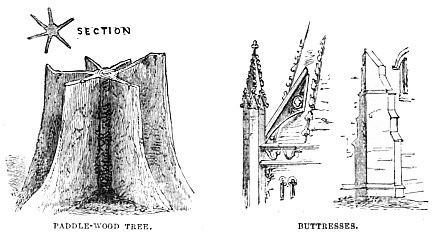
Nature, as well as Art, supplies her buttresses. In our own country we find the natural buttress more or less developed in our trees, as it is wanted.
Take, for example, any plantation, and examine the trees. It will be found that those in the centre, which are sheltered on all sides from the force of the wind, shoot up straight towards the light, have comparatively slight and slender stems, and occasionally display such energy in forcing themselves upwards, that when two branches find that there is not room for both, they form a sort of alliance, fuse themselves together, and force their united way towards the sky.
Take, however, the trees in the outside rows of the plantation, and see how they throw out their straight roots and branches towards the outside, and how, on the inside, their trunks are as smooth and their roots as little visible as those of the trees that grow in the centre of the plantation.
Almost any tree will develop itself in this fashion, showing that instinct can rule the vegetable as well as the animal world.
There is, however, a South American tree which far surpasses any of our trees in its power of throwing out spurs or buttresses, principally, I presume, because it may have to endure the fiercest storms from any quarter and at any time. So bold are these projections that several men would be hidden if standing between two of them, and so numerous are they that if a section of the tree were taken at the base of the ground, it would resemble a conventional star or asterisk, *, rather than an ordinary tree-trunk, O.
The scientific name of this curious tree is Aspidomorpha excelsum.
The natural buttresses are so thin and so wide that they look like large planks set on end, with one edge against the tree. Indeed, they are used as planks, nothing more being required than to cut them from the tree.
This is very easy, as, while the wood is green, it is so soft that a blow from a “machete,” or native cutlass, is sufficient to separate it. With the same instrument the native makes these flat planks into paddles for his canoe, the soft wood yielding readily even to the imperfect edge of the rude tool. When the wood dries, it becomes very hard, light, and singularly elastic, all these properties qualifying it for its object. I have several of these paddles in my collection. They are much prized by the natives, and are always stained in various patterns with red and black dyes.
In consequence of the use which is made of this tree, it goes by the popular name of “paddle-wood.”
The Tunnel used as a PassageAs to this division of the subject, I have not been quite sure where it should be placed, but think the present position a tolerably appropriate one.
We have already, in the igloo of the Esquimaux and the winter dwelling of the seal, found examples of the Tunnel when used as an appendage to the houses and a means of security. We now come to the Tunnel as affording the means of locomotion.
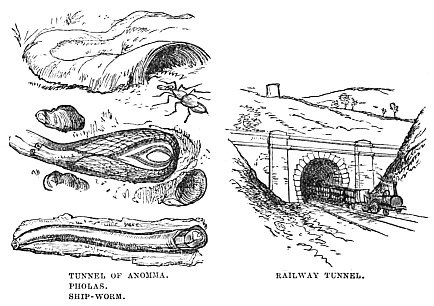
Take, for example, our own railway system. Had it not been for the power of tunnelling, the railway would have lost nearly its whole value, for it would have been restricted to local districts, and could not have penetrated, as it now does, to all parts of the country, without reference to hill, dale, or level ground. Our present system of engineering has wonderfully developed the capability of tunnelling. In former times it was thought a most wonderful feat to drive a tunnel under the Thames, while in these days the tunnel through Mont Cenis has been completed, and we are hoping to make a submarine tunnel from England to France.
In Nature we can find many examples of Tunnels used for similar purposes. The silken tunnel of the Wax-moth larva has already been mentioned, and we now come to Tunnels where earth in some form, and not silk, is the material of which they are constructed.
The lowermost figure on the left-hand side of the illustration represents that well-known and most destructive burrower, the Ship-worm (Teredo), which, by the way, in spite of its popular name, is not a worm, but a mollusc. This creature has a peculiar interest for engineering, inasmuch as its mode of working gave Brunel the first idea of subaquatic tunnelling in loose, sandy soil, just as the Victoria Regia leaf gave to Paxton the idea which afterwards developed into the Crystal Palace.
The plan adopted by the Ship-worm is at the same time simple and effective. It feeds upon wood, and gradually eats its way through almost any timber that may be submerged. It does not, however, merely bore its way through the timber, but lines its burrow with a coating of hard, shelly material. Taking this hint, Brunel proceeded in the same fashion to drive his tunnel through the very ungrateful soils which form the bed of the Thames.
He built a “shield,” as he called it, of iron, exactly fitting the tunnel, and divided into a number of compartments, each of which could be pushed forwards independently of the others. In each compartment was a single workman, and, as he excavated the earth in front of him, he pushed forward his portion of the shield, while the interior was cased with brickwork, just as a Teredo tunnel is cased with shell.
Above the Teredo is represented another marine tunnel-maker, as it appears in its burrow.
This is the mollusc popularly known as the Piddock, and scientifically as Pholas dactylus. It may be found abundantly in all our chalk cliffs, boring its tunnels deeply into the stone, and aiding the sea in its slow, but never-ending task of breaking down the cliffs on one side, while it gradually rears them up on another. As the material into which the Piddock burrows is so hard, there is no need for lining the tunnel, as is done by the Teredo. In this point, too, our engineers follow its example. When their tunnels pass through comparatively soft ground, they line it with masonry, proportioning the thickness of the lining to the looseness of the soil. But, when they come to solid rock, they are content with its strength, and do not trouble themselves about the lining.
The mode of action adopted by the Pholas has long been a disputed point, and even now appears to be not quite settled. I think, however, that William Robertson has proved by his experiments that the shell and the siphon are both brought into requisition. The shell perpetually rotates in one direction, and then back again, just like the action of a bradawl, and, by the file-like projections on its surface, rasps away the chalk, converting it into a fine powder. This powder, being of course mixed with water, passes into the interior of the animal, and is ejected through the siphon.
There are many species of Pholas which burrow into various substances, even in floating cakes of wax and resin. The same species, too, will burrow into different substances, and it is worthy of notice that those specimens which burrow into soft ground attain a much larger size, and their shells are in better preservation, than those which force their way through hard rock.
The uppermost figure represents a very remarkable tunnel, having the peculiarity of being built instead of sunk. It is the work of an African Ant belonging to the genus Anomma, and popularly known as the Driver-ant, because it drives away every living creature which comes across its course of march.
There are many Ants which seem to rejoice in the full blaze of the tropical sun, running about with ease on rocks which would scorch and raise blisters on the hand if laid on it, and finding no difficulty in obtaining the moisture needful for the mud walls of their habitations. But the Driver-ants cannot endure the sun, and, unless compelled by necessity, will not march except at night, or at all events during cloudy days. Should, however, they be absolutely forced to march in the sunshine, they construct as they go on a slight gallery, which looks very much like the lining of a tunnel stripped of the surrounding earth. If their path should lead them to thick herbage, sticks, &c., which form a protection from the sun, the Driver-ants do not trouble themselves to make a tunnel, but take advantage of the shade, and only resume the tunnel when they reach the open ground.
Sometimes, when they are on a marauding expedition, they construct a tunnel in a very curious manner, their own bodies supplying the materials. The reader must know that there are several classes of these insects, varying in size from that of a huge earwig to that of the little red ant of our gardens. The largest class seem to care little about the sunshine, the protection being mostly needed by the workers. The following is Dr. Savage’s account of their proceedings:—
“In cloudy days, when on their predatory excursions, or migrating, an arch for the protection of the workers is constructed of the bodies of their largest class. Their widely extended jaws, long, slender limbs, and projecting antennæ, intertwining, form a sort of network that seems to answer well their object.”
“Whenever an alarm is given, the arch is instantly broken, and the Ants, joining others of the same class on the outside of the line, who seem to be acting as commanders, guides, and scouts, run about in a furious manner in pursuit of the enemy. If the alarm should prove to be without foundation, the victory won, or danger passed, the arch is quickly renewed, and the main column marches forward as before, in all the order of an intellectual military discipline.”
How they should be able to direct their course, and to chase an enemy, is not easy to understand; for, as far as is known, they are absolutely blind, not even an indication of an eye being seen.
The Suspension-bridgeThe mention of these Ants brings us to another point in architecture. We have already seen that they can not only build arched tunnels, but also can form their own bodies into arches, and we shall presently see how they can form themselves into Suspension-bridges. We will, however, first take the Suspension-bridge, and its vegetable origin, before passing to the animal.
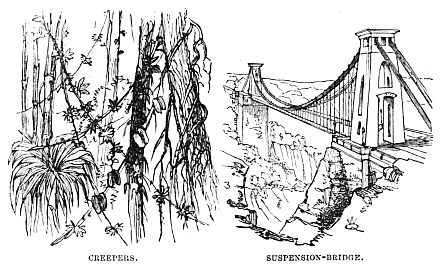
I have little if any doubt that the modern Suspension-bridge, with all its complicated mathematical proportions, was originally suggested by the creepers of tropical climates. There are few points in a tropical forest, no matter in what part of the world, more striking than the wonderful development of the creeping plants. The trees are very much like those of our own forests, and are in no way remarkable, but the creeping plants form the chief feature of the woods.
They extend themselves to unknown lengths, crawling up to the very summit of a lofty tree, hanging down to the very ground, if not caught by a midway branch, running along the earth, making their way up another tree, and so on ad infinitum. They interlace with each other, forming almost impenetrable thickets, as has already been mentioned while treating of Nets, and there is scarcely a tree that is not connected with its neighbour by means of these wonderful creeping plants.
Of course the monkey tribes make great use of them in passing from one tree to another, thus being able to avoid the ground, which is never to a monkey’s liking. Man, therefore, copies the example of the monkey, and makes use, either of the creepers themselves, or of ropes stretched from tree to tree in imitation of them.
In some parts of the world, where palm wine, or “toddy,” is manufactured, the native has recourse to an ingenious device which saves a vast amount of exertion. As the calabash which receives the juice of the palm-tree is always fixed at a considerable height, and as each tree only yields a limited supply, the toddy-maker would be obliged to ascend and descend a great number of trees before he could collect his supply of palm-juice.
In order to save himself trouble, he has the ingenuity to connect the trees with each other by two ropes, the one about six feet above the other. He then has only to ascend once, and descend once, for he ascends one tree, and by means of the ropes passes from tree to tree without needing to descend.
The mode of traversing these ropes is simple enough, the lower rope serving as a bridge, along which the man walks, and the upper rope being held by the hands. Those who see these palm-wine makers for the first time are always greatly struck. At some little distance the ropes are quite invisible, and the man appears to be walking through the air without any support whatever.
In Borneo the Rattan is continually put in requisition as a bridge. It runs to almost any length, a hundred feet more or less being of little consequence; it is lithe and pliant, and so strong that it can hardly be broken. The “canes” formerly so much in vogue among schoolmasters, and now so generally repudiated, are all cut from the Rattan. Chiefly by means of this natural rope, the Dyak of Borneo flings his rude suspension-bridges across chasms or rivers, and really displays a wonderful amount of ingenuity in doing so.
The one fault of these bridges is their tendency to decay, or perhaps to be eaten by the multitudinous wood-eating insects which swarm in that country. However, the materials cost nothing at all, and time scarcely more, so that when a bridge breaks down, any man can fit up another at the expense of a few hours’ work. As, moreover, the Dyaks have a curious way of building their houses on one side of a ravine, they find that a bridge of this kind saves them the trouble of descending and ascending the ravine whenever they wish to visit their house.
In many parts of America the Suspension-bridge is almost a necessity. The country is broken up by vast clefts, technically called “cañons.” These cañons are ravines in the rocky ground, with sides almost perpendicular. For the greater part of the year they are dry, but sometimes, and without the least warning, they become the beds of roaring torrents, rising to some thirty or forty feet in height, and carrying away everything before them.
Over these ravines are thrown suspension-bridges made almost entirely of creepers, and loosely floored with rough planks. Although they are very strong, they appear to be very fragile, and even under the tread of a human being swing and sway about in a manner that always shakes the nerves of one who is unaccustomed to them. Yet, even the mules of the country can cross them, the animals picking their way with the wonderful sure-footedness of their kind, and not in the least affected by the swaying of the bridge.
Passing from the vegetable to the animal world, we revert to the Driver-ants, which have already been mentioned. It has been seen that their soldier-ants can, with their own bodies, form a tunnel, under the shade of which the workers can pass, and we have now to see how they can, with the same materials, form a suspension-bridge.
It often happens that on their march they come to water, and, as they always advance with total disregard of difficulties, they must needs invent some very ingenious way of overcoming the difficulty. One of them climbs a branch which overhangs the water, clasps the undermost twig very tightly, and allows itself to hang from it. Another at once follows, and suspends itself from its comrade in like manner, the powerful and sicklelike jaws doing their duty as well as the legs. A chain of Ants is thus speedily formed. When the lowermost Ant touches the water, it merely spreads all its legs, and awaits the development of events. Another runs over it, holds to the first Ant by its hind-legs, and stands in the water, spreading its limbs as much as possible over the surface. Ant after Ant descends, until quite a long chain of the insects is formed, and is swept downwards with the stream. By slow degrees the chain is lengthened, until the Ants at its head are able to seize the bank on-the opposite side of the water. When they have succeeded in doing so, the bridge is complete, and over that living bridge will pour a whole army of Driver-ants.
Even in those cases where this mode of travelling would be too perilous on account of the rapid torrent, the Ants contrive to suspend themselves in long strings until they effect a communication with the trees of the opposite bank.
It is, perhaps, needless to give more than a passing reference to the Suspension-bridges made by Spiders, by means of which they can traverse considerable distances. The similar bridge of the Little Ermine Caterpillar has already been mentioned, when treating of the subject of Double Walls.
CHAPTER IV.
LIGHTHOUSES.—THE DOVETAIL.—THE DAM.—SUBTERRANEAN DWELLINGS.—THE PYRAMID.—MORTAR, PAINT, AND VARNISH
The Eddystone Lighthouse: its Position, and the Difficulties of building it.—Destruction of successive Lighthouses.—Smeaton’s Idea of Form borrowed from the Tree-trunk.—Mode of building.—Rooting it into the Rock.—Principle of the Dovetail.—Bones of the Human Skull, and their Articulation.—The Dam, and its Uses to Man.—The Lock and the Water-mill.—Dam of the Beaver: its Objects and Mode of Construction.—Popular Errors with regard to the Dam.—Subterranean Dwellings.—The Indian Palace, and its Use in Summer.—Subterranean Dwellings in Kamschatka, and their Use in Winter.—The Wood or Horse Ant, and its double Dwelling.—The upper and lower Nests used according to the Amount of Warmth required.—Section of the Nest, and a Glimpse into its Interior.—The Pyramid.—Derivation of its Name.—Natural Objects from which the Form was derived.—Subaquatic Mortar or Cement, and its Use to Man.—Subaquatic Cement used by the Caddis, the Stickleback, the Terebella, the Sabella, the Serpula, and others.—Paint and Varnish, and their Utility to Man.—Propolis as used by the Hive Bee, and the Source whence it is obtained.
WE now come to some points in Architecture which cannot well be grouped together, and must therefore be treated as Miscellanea.
Our first example is one which was avowedly based upon an imitation of Nature, namely, the celebrated Eddystone Lighthouse, and we shall see that in two points—first its form, and next the mode in which the stones were fixed together—Nature had been closely followed by the architect.
Unlike ordinary lighthouses, this edifice had to be constructed so as to endure the full force of waves as well as wind. A few miles from the southern coasts of Devon and Cornwall there is a rock which in former times greatly endangered the ships which passed along the Channel. Several attempts were made to build a lighthouse on this dangerous spot. Winstanley’s lighthouse, which was finished in 1700, was wholly swept away three years later, together with the architect himself, and some workmen who were engaged in repairs. So terrific is the force of the elements on this spot, that the lighthouse was entirely destroyed, and the only vestiges of it that were ever discovered were some iron bars and a piece of chain.
Another lighthouse was built a few years afterwards, but was burned down, it being of wood instead of stone. At last the work was put into the hands of Smeaton, who saw that he must build on a totally new plan. He took for his model the trunk of a tree, and determined to build his lighthouse of the same form as the tree-trunk, and to fasten it into the rock just as a tree is fastened by its roots. Accordingly, he struck out a new principle in the construction of such edifices, and his model has been followed ever since. The reader will see, by a glance at the illustration, how close is the resemblance in external form. I may mention that the tree in question was sketched from one in a paddock opposite my house.
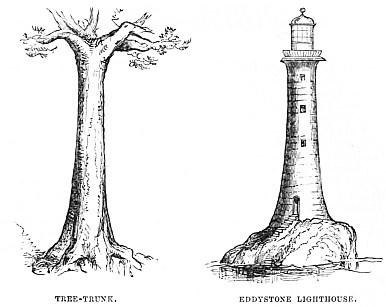
Having settled the form of the lighthouse, and made it like a tree-trunk, the next business was to fix it firmly in the rock, and, in fact, to give it roots of stone. For this purpose, he made the base of the edifice as wide as the rock would allow, so as to correspond with the wide base of a tree-trunk, and traced a circle of about ninety feet in circumference. Instead, however, of merely laying the stones as is usually done, or even letting them into holes cut in the rock, he hit upon a singularly ingenious device, whereby the building was practically a single stone.
Instead of cutting the stones square or oblong, as is usually done, he had them made so as to “dovetail” into each other, much after the fashion of a child’s puzzle toy, or the junctions at the edge of a box. Thus, each stone fitted into those around it, while the lowest tier was dovetailed in similar fashion into the rock.






